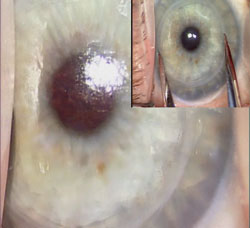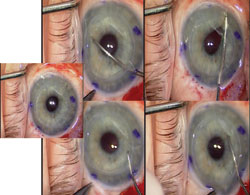DMEK used after PK for failed corneal graft
 Thomas John |
Full-thickness corneal transplantation, namely penetrating keratoplasty, is susceptible to corneal endothelial graft failure, corneal stromal and epithelial edema, secondary iritis with keratic precipitates, and compromised vision. When medical management of corneal graft rejection fails to restore the corneal graft, surgical intervention is necessary for visual rehabilitation.
A repeat PK would further weaken the cornea with a new, full-thickness corneal wound. However, performing Descemet’s membrane endothelial keratoplasty (DMEK), because it does not entail a full-thickness wound, has the advantage of retaining the original PK wound without further weakening the cornea. DMEK is an evolving corneal transplantation procedure that can be challenging both in terms of donor tissue preparation and donor Descemet’s membrane attachment to the recipient cornea.
In this column, I describe a surgical technique for performing DMEK in a failed corneal graft from a PK procedure that was performed 12 years prior.
Surgical technique
The preferred anesthesia for DMEK is topical anesthesia with monitored anesthesia care. However, peribulbar or general anesthesia may be used depending on surgeon preference. Figure 1 shows the full-thickness corneal graft with corneal stromal and epithelial edema resulting in an irregular corneal surface that causes disruption of the corneal light reflex. If the view of the anterior segment is blurred, the central corneal epithelium can be removed with a Weck-Cel spear to improve the view and facilitate the surgical procedure (Figure 1). DMEK is performed within the circular corneal wound. Crossing the wound onto the recipient peripheral cornea is not advised because this can cause suboptimal attachment of Descemet’s membrane to the recipient cornea and may result in postoperative Descemet’s membrane detachment. There is no need to make a circular mark on the corneal surface when performing DMEK on a previous PK. The PK wound is used as the circular guide when performing DMEK. Hence, the diameter of the corneal wound is measured using Castroviejo calipers (Figure 1), and this diameter is used in selecting the trephine for the donor cornea.
 Figure 1. Main figure: Intraoperative view of a 12-year-old full-thickness PK graft that failed with corneal stromal and epithelial edema. The epithelial edema resulted in an uneven corneal surface with disruption of the corneal light reflex. Note the healed, circular wound. Inset: Castroviejo calipers are used to measure the diameter of the corneal graft. Central epithelium is removed. |
 Figure 2. Top and bottom rows: Descemetorrhexis being performed within the corneal graft using the John Dexatome. Bottom right: The tip of the Dexatome spatula is in contact with the folded-over Descemet’s membrane and avoiding any contact with the exposed recipient, inner corneal stromal surface. Inset: Recipient cornea devoid of graft Descemet’s membrane. Images: John T |
Next, the anterior chamber is entered with a superblade, and the chamber is filled with viscoelastic such as Healon (sodium hyaluronate, Abbott Medical Optics). A John Dexatome spatula (ASICO) is used to perform the descemetorrhexis. This spatula has a curvature that facilitates this step of the procedure (Figure 2). It is essential not to exert undue pressure on the donor-recipient PK wound because this can result in wound dehiscence during the surgery, especially in more recent corneal wounds. It is best to remove the recipient Descemet’s membrane as a single disc. Additionally, avoid scraping the exposed recipient stroma during Descemet’s membrane removal because this will compromise the donor-recipient interface and may contribute to slower visual recovery after the surgery.
An inferior peripheral iridectomy is performed. The donor Descemet’s membrane is partially detached without tearing it under fluid (Figure 3). The donor Descemet’s membrane is then trephined using a disposable trephine with a diameter that matches that of the PK graft. The donor Descemet’s membrane is detached as a single disc, stained with trypan blue and introduced into the recipient anterior chamber (Figure 4). The corneal entry wound is closed with a single 10-0 nylon suture (Figure 4). The donor Descemet’s membrane is clearly visible with the blue stain.
 Figure 3. Hydro-manual detachment of the donor Descemet’s membrane. |
 Figure 4. Top left: Detached donor Descemet’s membrane is stained with trypan blue. Top right: Donor Descemet’s membrane is introduced into the recipient anterior chamber, and the entry wound is closed with a single 10-0 nylon suture. Bottom row: Descemet’s membrane being unfolded within the anterior chamber. |
 Figure 5. Top row: Donor Descemet’s membrane is unfolded, centered to coincide concentric with the graft wound and attached with an air bubble. Bottom row: The air bubble is expanded to extend beyond the corneal graft wound. |
The donor Descemet’s membrane disc is centered onto the PK graft, and then the Descemet’s membrane is unfolded using fluidics and avoiding direct mechanical contact. If the Descemet’s membrane fails to unfold in the desired manner, limited contact can be made using the John DMEK spatulas (ASICO) to help unfold the donor Descemet’s membrane within the recipient failed corneal graft. Once the unfolded donor Descemet’s membrane is well-centered, a blunt 30-gauge cannula is gently introduced between the Descemet’s membrane and the anterior iris surface, and air is injected in a controlled fashion to attach the donor Descemet’s membrane to the recipient corneal stroma (Figure 5). The air bubble is large enough to extend beyond the PK wound (Figure 5). Any nonadherent edematous corneal epithelium that remains may be removed using a Weck-Cel spear. Intraoperative slit lamp is used to sweep the entire Descemet’s membrane disc to ensure uniform attachment of the donor Descemet’s membrane to the PK graft without any interface gaps (Figure 6). The completed view of the procedure is shown in Figure 6.
 Figure 6. Intraoperative slit lamp view ensures that the donor Descemet’s membrane is uniformly attached to the inner surface of the failed donor corneal graft without any gap in the donor-recipient interface. Any suboptimal attachment can be corrected intraoperatively. Insert: Well-centered, uniformly attached donor Descemet’s membrane. |
Surgical pearls
1. Type of anesthesia is dependent on the surgeon. Topical anesthesia with monitored anesthesia care usually works well.
2. Use the diameter of the PK graft to select the donor trephine. This will prevent the donor Descemet’s membrane from crossing over the corneal wound onto the recipient cornea, which could inhibit optimal Descemet’s membrane attachment.
3. Avoid undue pressure on the PK wound while performing descemetorrhexis to prevent PK wound dehiscence. The John Dexatome spatula facilitates this surgical step.
4. While detaching the donor Descemet’s membrane under fluid, it is important to look at the margins of separation to avoid accidental tearing.
5. An inferior peripheral iridectomy is essential to prevent postoperative pupillary block.
6. Ensure good centration of the donor Descemet’s membrane onto the failed PK graft.
7. Ascertain good, uniform adherence of the donor Descemet’s membrane to the recipient cornea without any gaps. Poor adherence often results in postop detachment. Intraoperative slit lamp helps visualize the donor-recipient interface.
8. A large air bubble is usually necessary to hold the thin Descemet’s membrane in place.
9. Avoid unnecessary manipulations of the donor Descemet’s membrane to limit donor endothelial cell loss.
References:
- Dapena I, et al. Standardized “no-touch” technique for descemet membrane endothelial keratoplasty. Arch Ophthalmol. 2011;129(1):88-94.
- Fernandez MM, Afshari NA. Endothelial keratoplasty: from DLEK to DMEK. Middle East Afr J Ophthalmol. 2010;17(1):5-8.
- Ham L, van Luijk C, Dapena I, et al. Endothelial cell density after descemet membrane endothelial keratoplasty: 1- to 2-year follow-up. Am J Ophthalmol. 2009;148(4):521-527.
- Thomas John, MD, is a clinical associate professor at Loyola University at Chicago and is in private practice in Oak Brook, Tinley Park and Oak Lawn, Ill. He can be reached at 708-429-2223; email: tjcornea@gmail.com.
- Disclosure: Dr. John receives a small royalty from ASICO.

